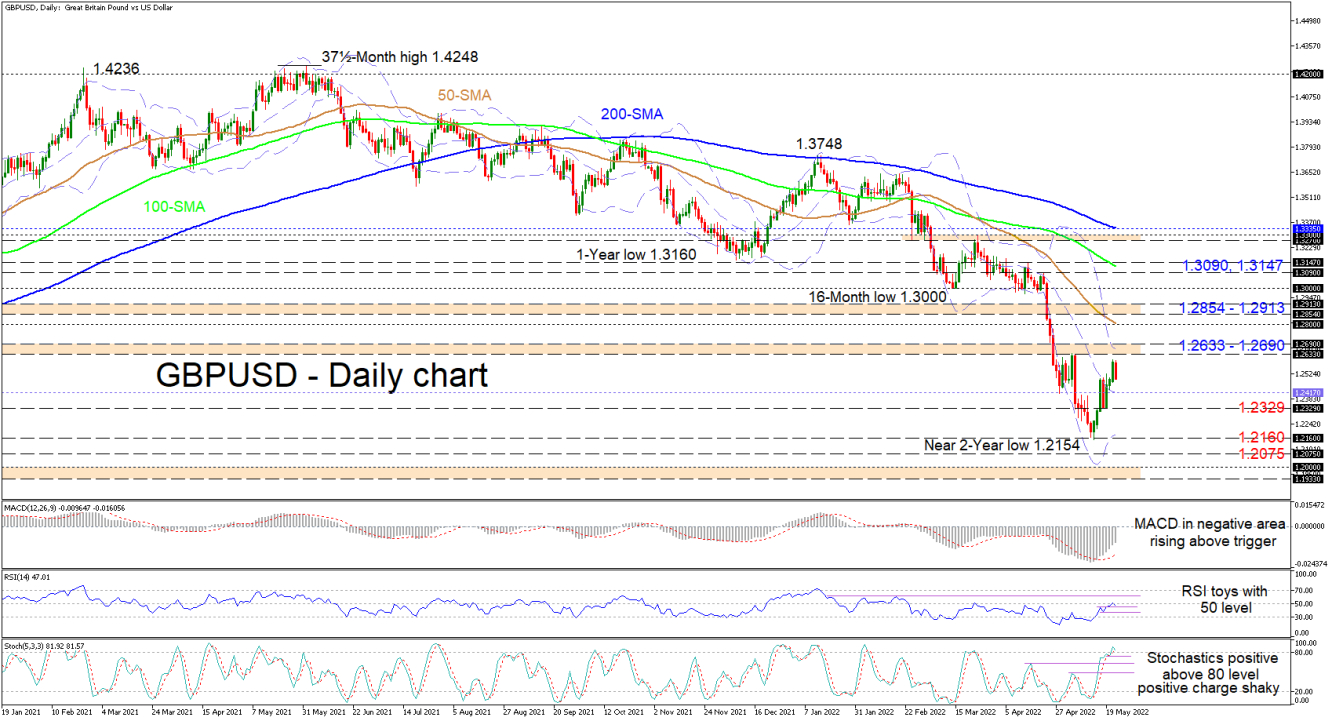GBP/USD’s Broader Bearish Bias Under The Microscope
XM Group | May 24, 2022 07:13AM ET
The diving simple moving averages (SMAs) are still backing the downward trend despite significant developments in the pair, after bouncing around two-year low levels.
Lately, the short-term oscillators have been indicating a constant dwindling in negative momentum, but sellers are starting to push back. The MACD is distancing itself above its red trigger line in negative territory, while the RSI is flirting with the 50 threshold. Meanwhile, the stochastic oscillator has been maintaining a sturdy positive charge in the overbought section, but this promotion of additional upside price action is now being questioned with the dipping in the %K line.
To the upside, tough resistance could originate from the nearby 1.2633-1.2690 boundary, which also encapsulates the upper Bollinger band. Conquering this barrier, the bulls may then target the falling 50-day SMA around the 1.2800 handle before challenging the 1.2854-1.2913 resistance border that stretches back to mid-October 2020. If positive pressures endure, the pair could lift higher to test the 1.3000 hurdle where March and April lows previously froze.
On the flipside, if buying interest continues to fade, support could commence around the mid-Bollinger band at 1.2417 ahead of the 1.2329 low. Steering even lower may boost negative movement in the pair with sellers aiming for the reinforced 1.2160 support, where the lower Bollinger band currently resides and marginal price slippage occurred, recording a near two-year low of 1.2154. If the pair remains heavy and sinks past these obstacles, which would revive the broader bearish trend, the 1.2000 mark could promptly come under attack.
Summarizing, GBPUSD is exhibiting a stubborn broader bearish bias below the 1.2633-1.2690 resistance obstacle and the falling SMAs. A dip in the pair past the mid-Bollinger band may strengthen selling pressures. That said, buyers’ confidence is likely to improve should they manage to steer the price over the 1.2633-1.2690 border, but for optimism to return in the pair, the price would need to pilot back to the 1.3000 price zone.


Trading in financial instruments and/or cryptocurrencies involves high risks including the risk of losing some, or all, of your investment amount, and may not be suitable for all investors. Prices of cryptocurrencies are extremely volatile and may be affected by external factors such as financial, regulatory or political events. Trading on margin increases the financial risks.
Before deciding to trade in financial instrument or cryptocurrencies you should be fully informed of the risks and costs associated with trading the financial markets, carefully consider your investment objectives, level of experience, and risk appetite, and seek professional advice where needed.
Fusion Media would like to remind you that the data contained in this website is not necessarily real-time nor accurate. The data and prices on the website are not necessarily provided by any market or exchange, but may be provided by market makers, and so prices may not be accurate and may differ from the actual price at any given market, meaning prices are indicative and not appropriate for trading purposes. Fusion Media and any provider of the data contained in this website will not accept liability for any loss or damage as a result of your trading, or your reliance on the information contained within this website.
It is prohibited to use, store, reproduce, display, modify, transmit or distribute the data contained in this website without the explicit prior written permission of Fusion Media and/or the data provider. All intellectual property rights are reserved by the providers and/or the exchange providing the data contained in this website.
Fusion Media may be compensated by the advertisers that appear on the website, based on your interaction with the advertisements or advertisers.